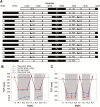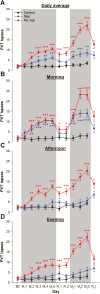Neurobehavioral Impact of Successive Cycles of Sleep Restriction With and Without Naps in Adolescents
- PMID: 28364507
- PMCID: PMC5806570
- DOI: 10.1093/sleep/zsw042
Neurobehavioral Impact of Successive Cycles of Sleep Restriction With and Without Naps in Adolescents
Abstract
Study objectives: To characterize adolescents' neurobehavioral changes during two cycles of restricted and recovery sleep and to examine the effectiveness of afternoon naps in ameliorating neurobehavioral deficits associated with multiple nights of sleep restriction.
Methods: Fifty-seven healthy adolescents (aged 15-19 years; 31 males) participated in a parallel group study. They underwent two cycles of sleep restriction (5-hr time in bed [TIB] for five and three nights in the first and the second cycles, respectively; 01:00-06:00) and recovery (9-hr TIB for two nights per cycle; 23:00-08:00) intended to simulate the weekday sleep loss and weekend attempt to "catch up" on sleep. Half of the participants received a 1-hr nap opportunity at 14:00 following each sleep-restricted night, while the other half stayed awake. Sustained attention, sleepiness, speed of processing, executive function, and mood were assessed 3 times each day.
Results: Participants who were not allowed to nap showed progressive decline in sustained attention that did not return to baseline after two nights of recovery sleep. Exposure to the second period of sleep restriction increased the rate of vigilance deterioration. Similar patterns were found for other neurobehavioral measures. Napping attenuated but did not eliminate performance decline. These findings contrasted with the stable performance of adolescents, given 9-hr TIB each night in our recent study.
Conclusions: Adolescents' neurobehavioral functions may not adapt to successive cycles of sleep curtailment and recovery. In sleep-restricted adolescents, weekend "catch-up sleep," even when combined with napping during weekdays, is inferior to receiving a 9-hr sleep opportunity each night.
Keywords: adolescents; neurobehavioral functions; recovery sleep; repeated cycles; sleep restriction; sustained attention.
© Sleep Research Society 2016. Published by Oxford University Press [on behalf of the Sleep Research Society].
Figures


Similar articles
-
Differential effects of split and continuous sleep on neurobehavioral function and glucose tolerance in sleep-restricted adolescents.Sleep. 2019 May 1;42(5):zsz037. doi: 10.1093/sleep/zsz037. Sleep. 2019. PMID: 30753648 Free PMC article. Clinical Trial.
-
Cognitive Performance, Sleepiness, and Mood in Partially Sleep Deprived Adolescents: The Need for Sleep Study.Sleep. 2016 Mar 1;39(3):687-98. doi: 10.5665/sleep.5552. Sleep. 2016. PMID: 26612392 Free PMC article. Clinical Trial.
-
Neurobehavioral dynamics following chronic sleep restriction: dose-response effects of one night for recovery.Sleep. 2010 Aug;33(8):1013-26. doi: 10.1093/sleep/33.8.1013. Sleep. 2010. PMID: 20815182 Free PMC article. Clinical Trial.
-
Adolescent sleep restriction effects on cognition and mood.Prog Brain Res. 2019;246:55-71. doi: 10.1016/bs.pbr.2019.02.008. Epub 2019 Mar 22. Prog Brain Res. 2019. PMID: 31072563 Review.
-
Neurobehavioral Effects and Biomarkers of Sleep Loss in Healthy Adults.Curr Neurol Neurosci Rep. 2017 Sep 25;17(11):89. doi: 10.1007/s11910-017-0799-x. Curr Neurol Neurosci Rep. 2017. PMID: 28944399 Review.
Cited by
-
Cognitive effects of split and continuous sleep schedules in adolescents differ according to total sleep opportunity.Sleep. 2020 Dec 14;43(12):zsaa129. doi: 10.1093/sleep/zsaa129. Sleep. 2020. PMID: 32619240 Free PMC article.
-
Longitudinal association of nighttime sleep duration with emotional and behavioral problems among rural preschool children.Eur Child Adolesc Psychiatry. 2024 Jan;33(1):267-277. doi: 10.1007/s00787-023-02153-4. Epub 2023 Feb 13. Eur Child Adolesc Psychiatry. 2024. PMID: 36781466 Free PMC article.
-
Sleep restriction and human physiology and behavior: questions posed, answers found?J Clin Sleep Med. 2020 Dec 17;16(S1):7-8. doi: 10.5664/jcsm.8874. J Clin Sleep Med. 2020. PMID: 33054958 Free PMC article.
-
Influence of mid-afternoon nap duration and sleep parameters on memory encoding, mood, processing speed, and vigilance.Sleep. 2023 Apr 12;46(4):zsad025. doi: 10.1093/sleep/zsad025. Sleep. 2023. PMID: 36775965 Free PMC article. Clinical Trial.
-
Napping, sleep and affect in late- and short- sleeping adolescents: An actigraphy and daily diary study.Sleep Health. 2025 Jun;11(3):317-325. doi: 10.1016/j.sleh.2025.03.003. Epub 2025 Apr 29. Sleep Health. 2025. PMID: 40307148
References
-
- Gradisar M, Gardner G, Dohnt H. Recent worldwide sleep patterns and problems during adolescence: a review and meta-analysis of age, region, and sleep. Sleep Med. 2011; 12(2): 110–118. - PubMed
-
- National Sleep Foundation. Sleep in America poll: Teens and Sleep. Washington, DC:National Sleep Foundation; 2006.
-
- Do YK, Shin E, Bautista MA, Foo K. The associations between self-reported sleep duration and adolescent health outcomes: what is the role of time spent on Internet use? Sleep Med. 2013; 14: 195–200. - PubMed
-
- Ohida T, Osaki Y, Doi Y, et al. An epidemiologic study of self-reported sleep problems among Japanese adolescents. Sleep. 2004; 27(5): 978–985. - PubMed
Publication types
MeSH terms
LinkOut - more resources
Full Text Sources
Other Literature Sources
Medical
Research Materials

